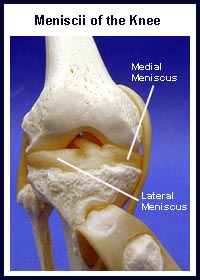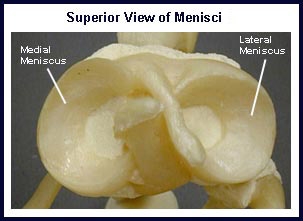
What is the meniscus of the knee?
The meniscus is a “C” shaped “shock absorber” which lies between the thigh bone (femur) and the shin bone (tibia). There is a meniscus on the inner (medial) side of the knee and one on the outer (lateral) side of the knee. Injuries to either the medial meniscus or the lateral meniscus are common and are often referred to as a “torn cartilage”.
What does a knee meniscus injury feel like?
Injuries to the menisci often result in pain and swelling in the knee. If the torn piece of meniscus is large, it may cause the knee to catch, lock, or give way ( read more about knee anatomy). Catching occurs when the torn fragment briefly lodges between the bones then works its way out. If the fragment does not work its way out the knee will remain “locked”, meaning the knee cannot fully bend or straighten. Locking can be brief (lasting seconds or minutes) or persistent (lasting weeks). Giving way occurs when the torn piece of meniscus slips out of place which causes pain and reflex relaxation of the thigh muscles. When the muscles relax the knee “gives way” or “gives out.”
What causes a meniscus tear?
The most common cause of sudden (acute) meniscal tears in younger people is a combined loading and twisting injury to the knee. However, the medial or lateral meniscus can undergo a degenerative tear without any significant injury to the knee. The medial meniscus is more frequently injured than the lateral meniscus.

Superior View
Meniscal injuries are often associated with a ligament tear of the knee. An injury to one of the main supporting ligaments of the knee can result in an unstable knee increasing the chance of tearing a meniscus. When a meniscus is injured the knee often becomes painful and/or swollen. The pain is usually made worse by specific movements such as bending or twisting the knee. Certain maneuvers may produce a “click”, “pop” or sharp pain which is often localized to the medial or lateral joint line (the space between the thigh bone and the shin bone). Swelling can be caused from irritation of the knee joint by the torn meniscus.
How do you know if you’ve torn your menuscus?
X-rays cannot detect meniscal injuries but are useful to rule out wear and tear arthritis (osteoarthritis), loose pieces of bone or a broken bone which may mimic a “torn cartilage”. Occasionally a special test called Magnetic Resonance Imaging (MRI) is required. Arthroscopic surgery is helpful in both the diagnosis and treatment of these injuries.
What is the treatment for a meniscus tear?
Initially the treatment of meniscus injuries may include activity modification, ice, medication (to reduce pain and/or swelling) and physiotherapy. If a torn meniscus does not heal, and pain, swelling or intermittent catching persists, arthroscopic surgery may be necessary. Arthroscopic surgery is usually required if the knee remains locked.
